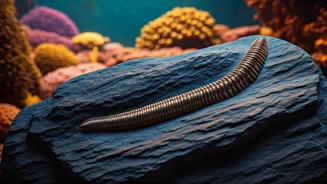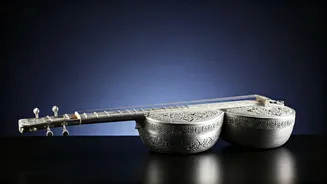Fossil Question Marks
The exploration of ancient life often presents mysteries, and one such puzzle resided in the fossil record, resembling a 'question mark'. These markings
were found on fossilized bivalve shells, hinting at some form of activity, but the exact origin remained unknown for a considerable time. Researchers found these markings to be particularly intriguing, sparking curiosity about their creation. The enigma of these traces, found within 480-million-year-old fossils, challenged scientists to delve deeper into the past, looking for clues to reveal their maker and function. The examination of these ancient shells involved meticulous analysis and innovative techniques, to unravel the secrets held within the stone. These efforts represent a fascinating intersection of paleontology and biological science, as scientists sought to understand the creators and how they lived in their environment.
Marine Worms' Handiwork
The mystery's solution came from the identification of the creators: marine worms known as spionid polychaetes. These worms, akin to modern-day burrowers, were responsible for creating the mysterious 'question marks'. They did so by boring into the shells of bivalves, leaving distinctive traces that were preserved over eons. The discovery of the spionid traces offered a glimpse into the lifestyle and behavior of these ancient creatures. The manner in which the worms interacted with their environment, creating tunnels and modifying their surroundings, also became apparent. The evidence shows that these worms actively interacted with the shells, and the fossils tell a story of their presence in the ancient marine ecosystem. This finding offered important insights into the biology of early marine ecosystems and added to the knowledge of their role in early life.
Fossil Analysis Revealed
The research methods used by scientists to decipher the mystery involved detailed analysis of fossilized shells. Advanced imaging techniques and careful observation allowed them to study the markings in great detail. The examination included analyzing the shape, size, and distribution of the traces, along with the shells themselves. The scientists also compared the fossilized traces to those created by modern-day spionid worms to confirm the connection. This methodical approach helped establish the precise nature of the interaction. The analysis confirmed the presence of spionids in the ancient oceans. The use of various scientific methods provided irrefutable evidence of the connection between the traces and marine worms. The study offered critical insight into the paleobiological process.
Insights on Ecosystems
The discovery provides significant insights into ancient marine ecosystems. The presence of these worms indicates complex interactions within those prehistoric environments. The worms were not just present; they actively shaped the landscape. This activity contributed to the structural organization of these ancient ecosystems. They influenced the environment and affected the structure of early marine life. The traces found in the fossil record indicate the existence of a balanced marine environment where various species interacted, each playing a role in the broader ecosystem. This research also helps understand the evolution of marine ecosystems. The findings provide a framework for future paleontological studies.











